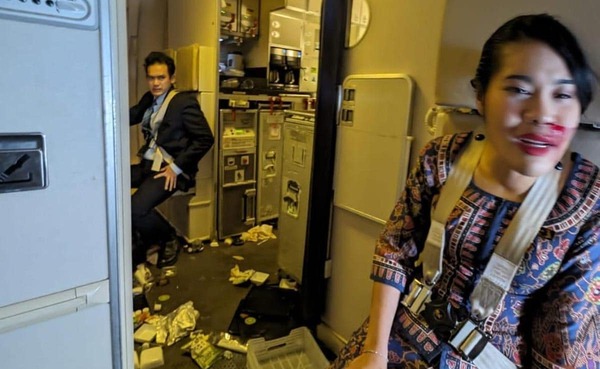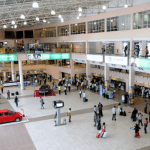One person has died and several others injured on a Singapore Airlines flight from London that was hit by severe turbulence.
The Singapore-bound Boeing 777-300ER was diverted to Bangkok and landed at 15:45 local (08:45 GMT).
Flight tracking data suggests the airliner dropped 6,000 feet (2,000m) in a matter of minutes after crossing the Bay of Bengal.
Flight SQ 321 was carrying a total of 211 passengers and 18 crew, the airline said in a statement.
The airline added that it was working with Thai authorities to provide medical assistance to passengers, and was sending a team to Bangkok to provide any additional help needed.
Thai authorities have despatched ambulances and emergency teams to Suvarnabhumi Airport.
Singapore’s Transport Minister Chee Hong Tat said the government would provide assistance to the passengers and their families.
What happened on board the flight is still unclear.
One passenger told Reuters news agency that the aircraft suddenly started “tilting up and there was shaking”.
Turbulence is most commonly caused by aircraft flying through cloud but there is also “clear air” turbulence which is not visible on a jet’s weather radar nor is it possible to predict.
Flight crews are also trained in how to respond to turbulence, he added.
Research has shown that climate change will make severe turbulence more likely in the future.
One person has died and several others injured on a Singapore Airlines flight from London that was hit by severe turbulence.
The Singapore-bound Boeing 777-300ER was diverted to Bangkok and landed at 15:45 local (08:45 GMT).
Flight tracking data suggests the airliner dropped 6,000 feet (2,000m) in a matter of minutes after crossing the Bay of Bengal.
Flight SQ 321 was carrying a total of 211 passengers and 18 crew, the airline said in a statement.
The airline added that it was working with Thai authorities to provide medical assistance to passengers, and was sending a team to Bangkok to provide any additional help needed.
Thai authorities have despatched ambulances and emergency teams to Suvarnabhumi Airport.
Singapore’s Transport Minister Chee Hong Tat said the government would provide assistance to the passengers and their families.
What happened on board the flight is still unclear.
One passenger told Reuters news agency that the aircraft suddenly started “tilting up and there was shaking”.
Turbulence is most commonly caused by aircraft flying through cloud but there is also “clear air” turbulence which is not visible on a jet’s weather radar nor is it possible to predict.
Flight crews are also trained in how to respond to turbulence, he added.
Research has shown that climate change will make severe turbulence more likely in the future.
One person has died and several others injured on a Singapore Airlines flight from London that was hit by severe turbulence.
The Singapore-bound Boeing 777-300ER was diverted to Bangkok and landed at 15:45 local (08:45 GMT).
Flight tracking data suggests the airliner dropped 6,000 feet (2,000m) in a matter of minutes after crossing the Bay of Bengal.
Flight SQ 321 was carrying a total of 211 passengers and 18 crew, the airline said in a statement.
The airline added that it was working with Thai authorities to provide medical assistance to passengers, and was sending a team to Bangkok to provide any additional help needed.
Thai authorities have despatched ambulances and emergency teams to Suvarnabhumi Airport.
Singapore’s Transport Minister Chee Hong Tat said the government would provide assistance to the passengers and their families.
What happened on board the flight is still unclear.
One passenger told Reuters news agency that the aircraft suddenly started “tilting up and there was shaking”.
Turbulence is most commonly caused by aircraft flying through cloud but there is also “clear air” turbulence which is not visible on a jet’s weather radar nor is it possible to predict.
Flight crews are also trained in how to respond to turbulence, he added.
Research has shown that climate change will make severe turbulence more likely in the future.
One person has died and several others injured on a Singapore Airlines flight from London that was hit by severe turbulence.
The Singapore-bound Boeing 777-300ER was diverted to Bangkok and landed at 15:45 local (08:45 GMT).
Flight tracking data suggests the airliner dropped 6,000 feet (2,000m) in a matter of minutes after crossing the Bay of Bengal.
Flight SQ 321 was carrying a total of 211 passengers and 18 crew, the airline said in a statement.
The airline added that it was working with Thai authorities to provide medical assistance to passengers, and was sending a team to Bangkok to provide any additional help needed.
Thai authorities have despatched ambulances and emergency teams to Suvarnabhumi Airport.
Singapore’s Transport Minister Chee Hong Tat said the government would provide assistance to the passengers and their families.
What happened on board the flight is still unclear.
One passenger told Reuters news agency that the aircraft suddenly started “tilting up and there was shaking”.
Turbulence is most commonly caused by aircraft flying through cloud but there is also “clear air” turbulence which is not visible on a jet’s weather radar nor is it possible to predict.
Flight crews are also trained in how to respond to turbulence, he added.
Research has shown that climate change will make severe turbulence more likely in the future.
One person has died and several others injured on a Singapore Airlines flight from London that was hit by severe turbulence.
The Singapore-bound Boeing 777-300ER was diverted to Bangkok and landed at 15:45 local (08:45 GMT).
Flight tracking data suggests the airliner dropped 6,000 feet (2,000m) in a matter of minutes after crossing the Bay of Bengal.
Flight SQ 321 was carrying a total of 211 passengers and 18 crew, the airline said in a statement.
The airline added that it was working with Thai authorities to provide medical assistance to passengers, and was sending a team to Bangkok to provide any additional help needed.
Thai authorities have despatched ambulances and emergency teams to Suvarnabhumi Airport.
Singapore’s Transport Minister Chee Hong Tat said the government would provide assistance to the passengers and their families.
What happened on board the flight is still unclear.
One passenger told Reuters news agency that the aircraft suddenly started “tilting up and there was shaking”.
Turbulence is most commonly caused by aircraft flying through cloud but there is also “clear air” turbulence which is not visible on a jet’s weather radar nor is it possible to predict.
Flight crews are also trained in how to respond to turbulence, he added.
Research has shown that climate change will make severe turbulence more likely in the future.
One person has died and several others injured on a Singapore Airlines flight from London that was hit by severe turbulence.
The Singapore-bound Boeing 777-300ER was diverted to Bangkok and landed at 15:45 local (08:45 GMT).
Flight tracking data suggests the airliner dropped 6,000 feet (2,000m) in a matter of minutes after crossing the Bay of Bengal.
Flight SQ 321 was carrying a total of 211 passengers and 18 crew, the airline said in a statement.
The airline added that it was working with Thai authorities to provide medical assistance to passengers, and was sending a team to Bangkok to provide any additional help needed.
Thai authorities have despatched ambulances and emergency teams to Suvarnabhumi Airport.
Singapore’s Transport Minister Chee Hong Tat said the government would provide assistance to the passengers and their families.
What happened on board the flight is still unclear.
One passenger told Reuters news agency that the aircraft suddenly started “tilting up and there was shaking”.
Turbulence is most commonly caused by aircraft flying through cloud but there is also “clear air” turbulence which is not visible on a jet’s weather radar nor is it possible to predict.
Flight crews are also trained in how to respond to turbulence, he added.
Research has shown that climate change will make severe turbulence more likely in the future.
One person has died and several others injured on a Singapore Airlines flight from London that was hit by severe turbulence.
The Singapore-bound Boeing 777-300ER was diverted to Bangkok and landed at 15:45 local (08:45 GMT).
Flight tracking data suggests the airliner dropped 6,000 feet (2,000m) in a matter of minutes after crossing the Bay of Bengal.
Flight SQ 321 was carrying a total of 211 passengers and 18 crew, the airline said in a statement.
The airline added that it was working with Thai authorities to provide medical assistance to passengers, and was sending a team to Bangkok to provide any additional help needed.
Thai authorities have despatched ambulances and emergency teams to Suvarnabhumi Airport.
Singapore’s Transport Minister Chee Hong Tat said the government would provide assistance to the passengers and their families.
What happened on board the flight is still unclear.
One passenger told Reuters news agency that the aircraft suddenly started “tilting up and there was shaking”.
Turbulence is most commonly caused by aircraft flying through cloud but there is also “clear air” turbulence which is not visible on a jet’s weather radar nor is it possible to predict.
Flight crews are also trained in how to respond to turbulence, he added.
Research has shown that climate change will make severe turbulence more likely in the future.
One person has died and several others injured on a Singapore Airlines flight from London that was hit by severe turbulence.
The Singapore-bound Boeing 777-300ER was diverted to Bangkok and landed at 15:45 local (08:45 GMT).
Flight tracking data suggests the airliner dropped 6,000 feet (2,000m) in a matter of minutes after crossing the Bay of Bengal.
Flight SQ 321 was carrying a total of 211 passengers and 18 crew, the airline said in a statement.
The airline added that it was working with Thai authorities to provide medical assistance to passengers, and was sending a team to Bangkok to provide any additional help needed.
Thai authorities have despatched ambulances and emergency teams to Suvarnabhumi Airport.
Singapore’s Transport Minister Chee Hong Tat said the government would provide assistance to the passengers and their families.
What happened on board the flight is still unclear.
One passenger told Reuters news agency that the aircraft suddenly started “tilting up and there was shaking”.
Turbulence is most commonly caused by aircraft flying through cloud but there is also “clear air” turbulence which is not visible on a jet’s weather radar nor is it possible to predict.
Flight crews are also trained in how to respond to turbulence, he added.
Research has shown that climate change will make severe turbulence more likely in the future.














